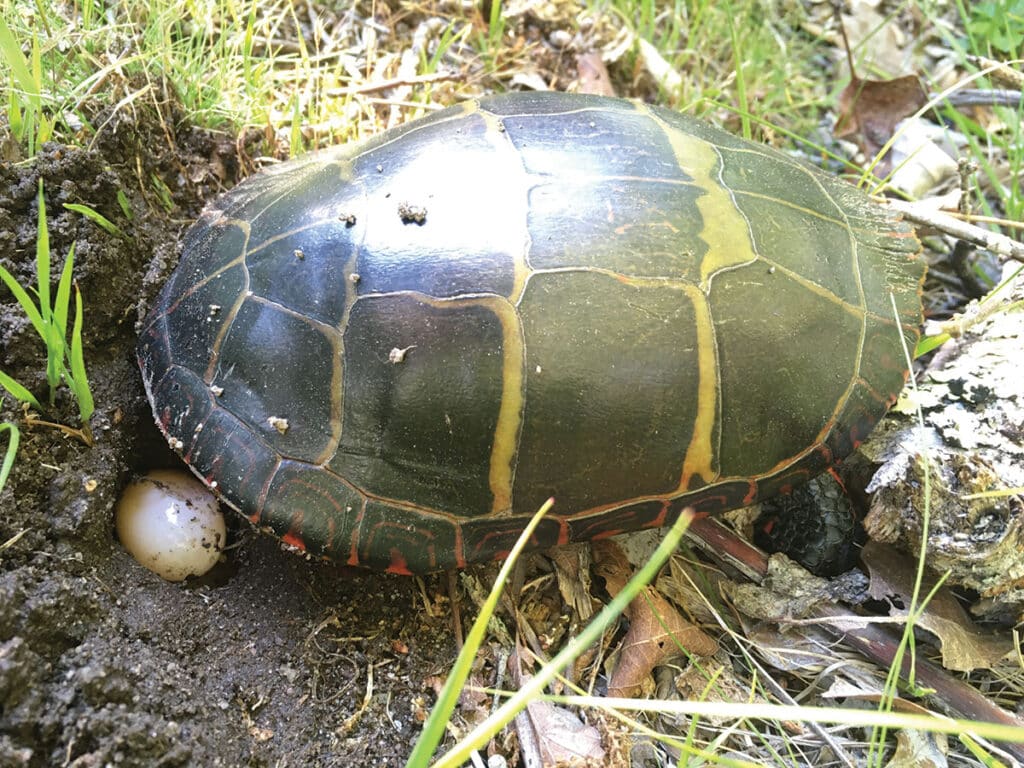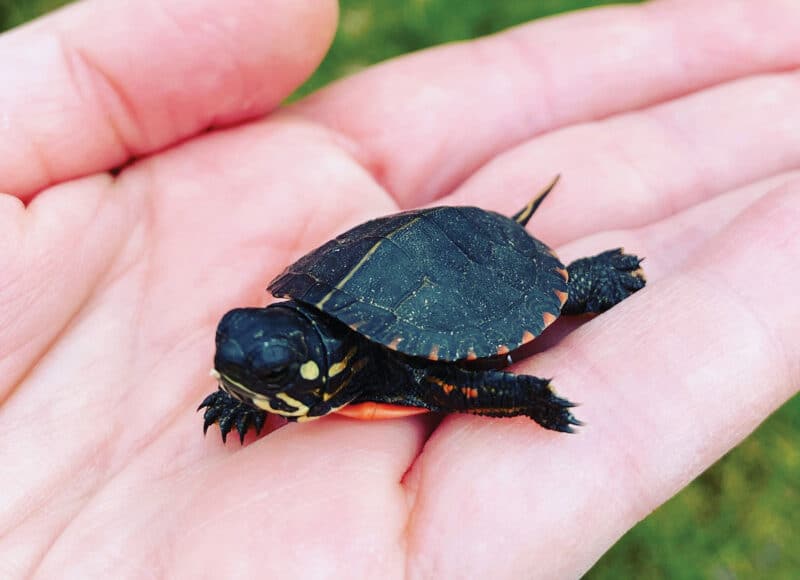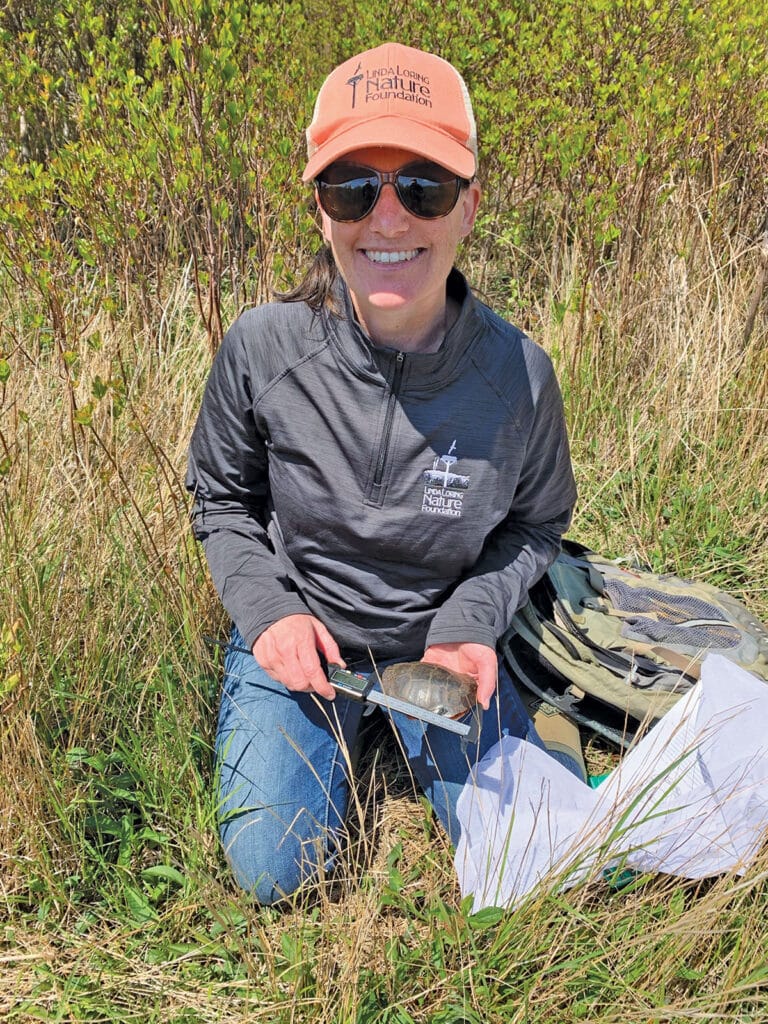by Dr. Sarah Treanor Bois, PhD
Director of Research & Education at the Linda Loring Nature Foundation
There are three species of native freshwater turtles on Nantucket (in addition to a few illegally released pets). You can find previous articles about the beloved spotted turtle (Clemmys guttata) or the ubiquitous and prehistoric snapping turtle (Chelydra serpentina). The third turtle species to roam Nantucket’s freshwater and uplands is the common, native eastern painted turtle (Chrysemys picta picta). The painted turtle is the most widespread native turtle of North America and they are fairly abundant throughout their range (coast to coast through the northern US and southern Canada, south to the Gulf of Mexico from Louisiana to southwestern Alabama).
Oftentimes when things are common and native they are overlooked and understudied. It’s like being ever-present makes it somehow less special. In scientific research we see this phenomenon with study subjects. The things more often studied are rare, endangered, or spectacularly charismatic. The flipside of that are the maligned species that are invasive, toxic, or otherwise cause harm which warrant research dollars and investigation. However, we can learn a lot from looking closely at our most common native species, such as the painted turtle.
Painted turtles (in our case the eastern variety) can be distinguished from other turtles by the bright yellow stripes behind the eyes and by the beautiful red and orange markings on the edge of their smooth, dark shell (carapace) and the bony plate on the underside (plastron). Our painted turtles are generally bigger than the spotted turtles at maturity but much smaller than the massive snapping turtles found in Nantucket’s deeper bodies of water.
Painted turtles are ubiquitous in most freshwater ecosystems on Nantucket, including ponds, bogs, marshes, and wooded swamps. Their ability to adapt to aquatic environments altered by humans contributes to the relative stability of many populations of the species. Like snapping turtles, painted turtles are omnivorous. With a large part of their diet consisting of insects, salamanders, frogs, and small fish, but they will also eat aquatic plants, like a little side salad.

The preferred habitat of the painted turtle has aquatic vegetation, soft sub-strate, and basking sites. They bask frequently; they are the most common basking turtle seen on logs, rocks, and pond edges. A great way to see them in their natural habitat is to take a kayak or canoe out on one of Nantucket’s great ponds: Miacomet, Hummock, Long Pond or the smaller ponds like Maxcy. Quietly gliding along the water, you may be able to get reasonably close to a basking site before hearing the “plop” as a turtle drops in to the cool water.
Many people have reported seeing painted turtles lately along trails and crossing roads. That is because now is prime nesting time for all of our turtles. Nesting season is from late May to early July, with a peak in mid-June. You’ll see them wandering out of the water into the upland, sometimes crossing roads and paths to reach a favorite nesting ground. They nest usually close to water’s edge in sandy or loamy area with open canopy, but any sandy spot seems to do. Typically 5-8 eggs are deposited in shallow, excavated depressions. The eggs hatch in late summer or early fall, but hatchlings for painted turtles usually remain in the nest until they emerge the following spring. Hatchlings are more carnivorous than adults and grow quickly, sometimes doubling in size in their first growing season.
Please be aware that right now turtles are crossing the pavement to get from their wintering grounds to another wetland or water area or to their nesting areas. If you see a turtle in the road, please avoid it! If it is safe to do so, here are a few tips essential for turtle safety and for your safety:
• First: slow down, stop, and let the turtle pass. If it is stopped or if you think you can SAFELY move the turtle, follow the directions below.
• If moving a turtle, always bring it to the road edge in the direction it was headed. If you don’t s/he will likely try to cross the road again. (Turtles have places to go, too!)
• Never pick up a turtle by the tail. You can permanently damage their vertebrae.
• Even if snapping turtles look old and slow, they can move fast and are likely to bite because they feel threatened. If you have a shovel or a broom in your car, you can help them scoot across the road.
It is also a good time of year to remember that we should leave wild animals where they are–that goes for turtles as well as baby birds, deer, and rabbits. It is illegal for individuals to possess and/or raise any species of wild animal in captivity. The spotted turtle is specifically illegal to possess because it is a protected species. The eastern painted and snapping turtles require a permit to possess live or dead individuals (including shells). Resist the urge to take home any of these critters. The care requirements in captivity can be astonishing. A turtle’s needs can be easily met in the wild, where there’s lots of food, water, sunlight, and space to meet their individual, social, and ecological needs. It is difficult, if not impossible, to meet these same requirements in a human’s home. They may seem very vulnerable, but they’ve evolved to persist over time. Nature knows best!
The Linda Loring Nature Foundation (LLNF) is currently collecting data on freshwater turtle species of their property. With the extensive wetland habitats throughout the Eel Point Road property, knowing more about their habitat use throughout the seasons helps in the planning of trails and conservation management. Spotted turtles are a conservation target of this work, but LLNF scientists are also collecting life history data on our common painted turtles.
The data collected on size, weight, location, and sex of individuals helps build a baseline dataset for the organization. Data on common species when populations are abundant, help provide vital information in the future as things change; whether it’s population size, species health, habitat loss, etc. This is only the second year of data collection for this common species, but LLNF plans to continue the project for at least the next few years.
If you are interested in more about our Nantucket reptiles, check out the Facebook page “Herping Nantucket” where people share sightings of reptiles around the island. You can also often find a painted turtle at the Mara Mitchell Association’s Natural Science Museum on Vestal Street, where they have a live animal room.




